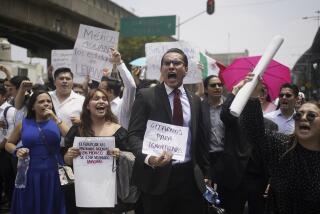A warning sign in Mexico
- Share via
It’s the economy, estupido. And the drug violence, lack of security and failure to end impunity for well-connected lawbreakers. It’s a legacy of corruption. For all those reasons, Mexico’s ruling National Action Party took a hammering in this week’s midterm elections from frustrated voters, many of whom turned back to the Institutional Revolutionary Party, which ruled for almost 70 years before being discredited and ousted nearly a decade ago.
As voters went to the polls, the numbers painted a grim picture for President Felipe Calderon and his PAN party: Mexico’s economy is expected to shrink 8% this year, thanks to lack of demand for its exports, a sputtering oil industry and a swine flu outbreak that decimated the tourism business. Remittances from workers in the U.S. are down by about 20%, and new jobs have dried up in el norte. On the upswing, meanwhile, are drug-related killings -- about 11,000 since Calderon took office in December 2006.
Voters blamed the incumbents for all this and handed the PRI (the Spanish acronym for the opposition party) five of the six contested governorships and a majority in the lower house of the Congress, positioning the party as the front-runner for the 2012 presidential election. While the impulse to “throw the bums out” is natural, the risk is that public disappointment with the PAN will turn into disillusionment with democracy itself. Turnout in Mexico has been declining, with more than half of registered voters abstaining from the most recent election and an additional 5% responding to a campaign to deface their ballots in protest against bad government.
It’s troubling that voters are returning to the PRI, which through patronage and coercion turned Mexico into a single-party state during most of the 20th century. The PRI controlled not only government but unions, business groups and the media, and was riddled with corruption. Today, the PRI presents itself as a party reformed by its time in the opposition, but that remains to be seen. Although it no longer controls the presidency, the PRI still holds most state legislatures, governorships and municipalities.
We hope voters are simply punishing the PAN for its shortcomings rather than longing for a return to a one-party patronage state. The leftist party that almost won the presidency last year, the Democratic Revolutionary Party, has become hopelessly divided and an ineffectual opposition force. If Calderon hopes to salvage the PAN, he needs to improve the economy and public safety as well as reform the judiciary. Mexican faith in government and the legitimacy of the political system may well depend on it.
More to Read
Sign up for Essential California
The most important California stories and recommendations in your inbox every morning.
You may occasionally receive promotional content from the Los Angeles Times.










